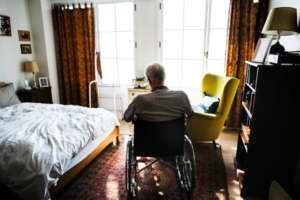According to the NHS, our bodies begin to exhibit certain changes as we near the end of life. While these signs can differ from person to person, it’s crucial to understand how to recognize them.
These physical signs usually persist for hours or even several days as someone approaches the end of life.
The 9 Signs Someone Is Approaching the End of Life

If you have a terminally ill elderly relative living with you, it’s important to recognize the signs that they may be nearing the end of life. There are 9 physical changes to be aware of, including weakness, increased sleeping, and a decreased appetite. Let’s take a closer look at these signs below.
Constant Drowsiness and Fatigue
At the end of life, people often have much less energy than they did when they were healthy. As a result, they may feel constantly drowsy and spend a lot of time sleeping. It’s best to let them rest when they need to. Ensure they are as comfortable as possible, and assist them in changing positions every couple of hours for their well-being.
Loss of Appetite

When people reach the end of life, many of their organs begin to shut down. They also become extremely weak. This makes drinking or eating particularly difficult. You should contact a healthcare professional to organize an alternative way of getting nutrition into their body. If they are not able to drink, you can try to keep them comfortable by applying balm to their lips.
Their Breathing Patterns Change
Per the NHS, your breathing patterns become irregular as you reach the end of your life . Often, the person’s breathing will alternate between shallow and deep breathing, with a slight pause after the deep breath. Due to the build-up of mucus, the breathing can often also sound noisy and rattle-like. [2] If you notice a change in their breathing patterns, try to change their position to one that makes breathing easier.
Hallucinations and Confusion

Certain end-of-life medications can cause chemical imbalances in the brain, occasionally causing confusion or hallucinations. The experts define hallucinations as perceiving things that aren’t actually there. This unusual behavior can obviously be unsettling and distressing for loved ones. Gently reminding the person of the current situation and who you are may help. Speaking in a calm and reassuring way can also minimize the chance of surprising or frightening the person.
Drop in Body Temperature
In the last days of a person’s life, blood circulation slows as it is concentrated in the internal organs. This leaves little blood able to flow to the extremities such as the hands, feet, and legs. As a result, the person’s skin can become cold to the touch. They also may appear pale or mottled with blue and purple patches becoming visible on their skin. Although the person may not feel cold, offering a blanket can help bring comfort.
Change in Toilet Habits

A person approaching de:at:h does not eat or drink much, so their bowel movements are also less frequent. As a result, they pass less solid waste and urinate less often. While these changes are often distressing, they are to be expected. If the dying person loses control of their bowel movements, you may want to bring in a caregiver to assist them.
Their Muscles Weaken
A terminally ill person’s muscles may weaken considerably. This makes it difficult for them to perform simple tasks, such as drinking from a cup or even just turning in bed. When this happens, you can offer support by helping with these activities. Gently assisting them with lifting objects or repositioning in bed can provide comfort and ease their discomfort during this difficult time.
They Become Less Social

As we mentioned earlier, as an individual reaches the end of life, their energy levels diminish considerably. This makes it difficult for them to engage with others as they once were able to. Their gradual withdrawal from social interactions is a natural part of the dying process, and you should not take it personally. It’s important to recognize that the person may need more rest and solitude. To ensure meaningful connections, you should try to plan your visits around the times when they feel up to having company. This will allow them to conserve their energy while still feeling supported.
Other Changes at End of Life
As de:at:h approaches, vital signs often undergo further significant changes. Blood pressure may drop, and the heartbeat can become rapid, faint, or irregular. The pulse may also become weak or difficult to detect. These changes are normal at the end of life, signaling that the body is beginning to shut down completely.





